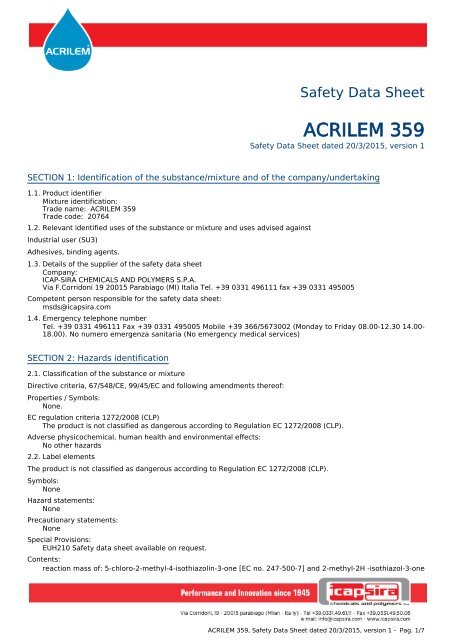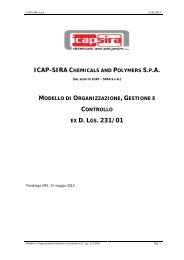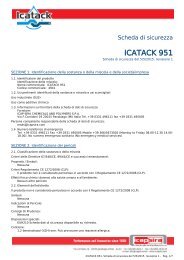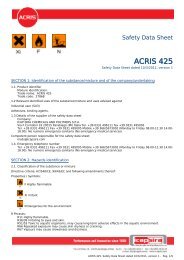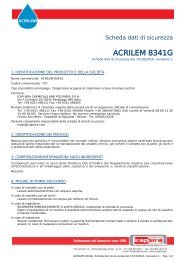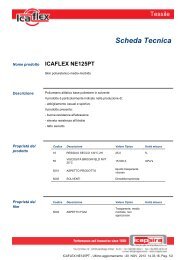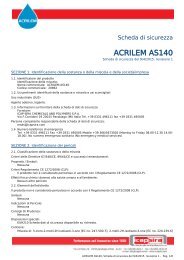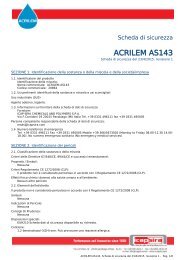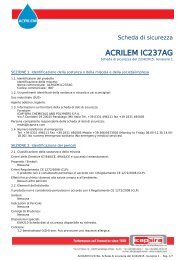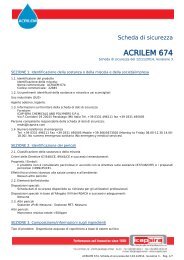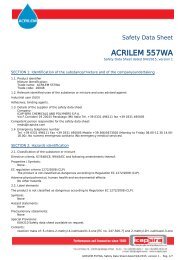ACRILEM 359
ACRILEM 359 - ICAP-SIRA Chemicals & Polymers SpA
ACRILEM 359 - ICAP-SIRA Chemicals & Polymers SpA
- No tags were found...
Create successful ePaper yourself
Turn your PDF publications into a flip-book with our unique Google optimized e-Paper software.
Safety Data Sheet<br />
<strong>ACRILEM</strong> <strong>359</strong><br />
Safety Data Sheet dated 20/3/2015, version 1<br />
SECTION 1: Identification of the substance/mixture and of the company/undertaking<br />
1.1. Product identifier<br />
Mixture identification:<br />
Trade name: <strong>ACRILEM</strong> <strong>359</strong><br />
Trade code: 20764<br />
1.2. Relevant identified uses of the substance or mixture and uses advised against<br />
Industrial user (SU3)<br />
Adhesives, binding agents.<br />
1.3. Details of the supplier of the safety data sheet<br />
Company:<br />
ICAP-SIRA CHEMICALS AND POLYMERS S.P.A.<br />
Via F.Corridoni 19 20015 Parabiago (MI) Italia Tel. +39 0331 496111 fax +39 0331 495005<br />
Competent person responsible for the safety data sheet:<br />
msds@icapsira.com<br />
1.4. Emergency telephone number<br />
Tel. +39 0331 496111 Fax +39 0331 495005 Mobile +39 366/5673002 (Monday to Friday 08.00-12.30 14.00-<br />
18.00). No numero emergenza sanitaria (No emergency medical services)<br />
SECTION 2: Hazards identification<br />
2.1. Classification of the substance or mixture<br />
Directive criteria, 67/548/CE, 99/45/EC and following amendments thereof:<br />
Properties / Symbols:<br />
None.<br />
EC regulation criteria 1272/2008 (CLP)<br />
The product is not classified as dangerous according to Regulation EC 1272/2008 (CLP).<br />
Adverse physicochemical, human health and environmental effects:<br />
No other hazards<br />
2.2. Label elements<br />
The product is not classified as dangerous according to Regulation EC 1272/2008 (CLP).<br />
Symbols:<br />
None<br />
Hazard statements:<br />
None<br />
Precautionary statements:<br />
None<br />
Special Provisions:<br />
EUH210 Safety data sheet available on request.<br />
Contents:<br />
reaction mass of: 5-chloro-2-methyl-4-isothiazolin-3-one [EC no. 247-500-7] and 2-methyl-2H -isothiazol-3-one<br />
<strong>ACRILEM</strong> <strong>359</strong>, Safety Data Sheet dated 20/3/2015, version 1 - Pag. 1/7
[EC no. 220-239-6] (3:1); reaction mass of: 5-chloro-2-methyl-4-isothi: May produce an allergic reaction.<br />
Special provisions according to Annex XVII of REACH and subsequent amendments:<br />
None<br />
2.3. Other hazards<br />
vPvB Substances: None - PBT Substances: None<br />
Other Hazards:<br />
No other hazards<br />
SECTION 3: Composition/information on ingredients<br />
3.1. Substances<br />
N.A.<br />
3.2. Mixtures<br />
Hazardous components within the meaning of EEC directive 67/548 and CLP regulation and related<br />
classification:<br />
None.<br />
SECTION 4: First aid measures<br />
4.1. Description of first aid measures<br />
In case of skin contact:<br />
Wash with plenty of water and soap.<br />
In case of eyes contact:<br />
In case of contact with eyes, rinse immediately with plenty of water and seek medical advice.<br />
In case of Ingestion:<br />
Do not under any circumstances induce vomiting. OBTAIN A MEDICAL EXAMINATION IMMEDIATELY.<br />
In case of Inhalation:<br />
Remove casualty to fresh air and keep warm and at rest.<br />
4.2. Most important symptoms and effects, both acute and delayed<br />
The symptoms and effects known most relevant, in case of exposure, are described on the label (section 2)<br />
and / or section 11. Other important symptoms and effects are not currently known.<br />
4.3. Indication of any immediate medical attention and special treatment needed<br />
Treatment:<br />
For more detailed information on the health effects and symptoms, see Section 11.<br />
SECTION 5: Firefighting measures<br />
5.1. Extinguishing media<br />
Suitable extinguishing media:<br />
Water.<br />
Carbon dioxide (CO2).<br />
Extinguishing media which must not be used for safety reasons:<br />
None in particular.<br />
5.2. Special hazards arising from the substance or mixture<br />
Do not inhale explosion and combustion gases.<br />
Burning produces heavy smoke.<br />
This material will not burn until the water has evaporated.<br />
Residue can burn. Upon burning, the dry product generates dense black smoke.<br />
When heated (decomposition) or in case of fire may liberate carbon oxides, gases and vapors which are<br />
dangerous to health.<br />
5.3. Advice for firefighters<br />
Use suitable breathing apparatus .<br />
Collect contaminated fire extinguishing water separately. This must not be discharged into drains.<br />
<strong>ACRILEM</strong> <strong>359</strong>, Safety Data Sheet dated 20/3/2015, version 1 - Pag. 2/7
Move undamaged containers from immediate hazard area if it can be done safely.<br />
SECTION 6: Accidental release measures<br />
6.1. Personal precautions, protective equipment and emergency procedures<br />
Wear personal protection equipment.<br />
Remove persons to safety.<br />
See protective measures under point 7 and 8.<br />
6.2. Environmental precautions<br />
Do not allow to enter into soil/subsoil. Do not allow to enter into surface water or drains.<br />
Retain contaminated washing water and dispose it.<br />
In case of gas escape or of entry into waterways, soil or drains, inform the responsible authorities.<br />
6.3. Methods and material for containment and cleaning up<br />
Suitable material for taking up: absorbing material, organic, sand<br />
Wash with plenty of water.<br />
6.4. Reference to other sections<br />
See also section 8 and 13<br />
SECTION 7: Handling and storage<br />
7.1. Precautions for safe handling<br />
Avoid contact with skin and eyes, inhaltion of vapours and mists.<br />
Do not eat or drink while working.<br />
See also section 8 for recommended protective equipment.<br />
7.2. Conditions for safe storage, including any incompatibilities<br />
Protect from freezing. Sensitive to cold from +5 ° C. Stored at temperatures between +5°C and +35°C.<br />
Keep away from food, drink and feed.<br />
Material may develop bacteria odor on long term storage.<br />
Incompatible materials:<br />
None in particular.<br />
See also section 10.<br />
Instructions as regards storage premises:<br />
Adequately ventilated premises.<br />
Flash point: N.A.<br />
7.3. Specific end use(s)<br />
None in particular<br />
SECTION 8: Exposure controls/personal protection<br />
8.1. Control parameters<br />
No occupational exposure limit available<br />
DNEL Exposure Limit Values<br />
N.A.<br />
Derived No Effect Level (DNEL), where indicated in SDS, it is a safe level of exposure derived from toxicological<br />
data in accordance with the REACH Regulation. DNEL may differ from an occupational exposure limit (OEL).<br />
The OEL may be recommended by a single company, a organization of state control or expert organization<br />
such as eg. ACGIH. The OEL DNEL are obtained by a different procedure.<br />
PNEC Exposure Limit Values<br />
N.A.<br />
8.2. Exposure controls<br />
Eye protection:<br />
Not needed for normal use. Anyway, operate according good working practices.<br />
Protection for skin:<br />
Chemical protection clothing.<br />
<strong>ACRILEM</strong> <strong>359</strong>, Safety Data Sheet dated 20/3/2015, version 1 - Pag. 3/7
Protection for hands:<br />
Not needed for normal use.<br />
Respiratory protection:<br />
Not needed for normal use.<br />
Thermal Hazards:<br />
None<br />
Environmental exposure controls:<br />
None<br />
The emissions from ventilation or work process equipment should be checked to ensure compliance with the<br />
directives of the binding legislation on environmental protection. In some cases, to reduce emissions, might be<br />
needed maintenance or technical plant modifications.<br />
SECTION 9: Physical and chemical properties<br />
9.1. Information on basic physical and chemical properties<br />
Appearance and colour: White liquid<br />
Odour: not significant<br />
Odour threshold: N.D. mg/m3<br />
pH: 3.4 25°C<br />
Melting point / freezing point: > 0°C<br />
Initial boiling point and boiling range: 100 °C<br />
Upper/lower flammability or explosive limits: No data (data not available).<br />
Vapour density: N.D.<br />
Flash point: N.A.<br />
Evaporation rate: N.D.<br />
Vapour pressure: N.A.<br />
Relative density: 1 g/cm3<br />
Solubility in water: completely miscible<br />
Partition coefficient (n-octanol/water): N.A.<br />
Auto-ignition temperature: non applicabile<br />
Decomposition temperature: N.D.<br />
Viscosity: 110 mPa.s (25°C) Brookfield RVT<br />
Explosive properties: Not Relevant<br />
Oxidizing properties: Not Relevant<br />
9.2. Other information<br />
Conductivity: N.D.<br />
Substance Groups relevant properties N.A.<br />
The values do not always conform to the specifications of the product. See the specific technical<br />
documentation for data.<br />
Solids content: 47,3 %<br />
SECTION 10: Stability and reactivity<br />
10.1. Reactivity<br />
Stable under normal conditions<br />
10.2. Chemical stability<br />
Stable under normal conditions<br />
10.3. Possibility of hazardous reactions<br />
None<br />
10.4. Conditions to avoid<br />
Stable under normal conditions.<br />
10.5. Incompatible materials<br />
None in particular.<br />
10.6. Hazardous decomposition products<br />
None.<br />
When heated (decomposition) or in case of fire may liberate carbon oxides, gases and vapors which are<br />
<strong>ACRILEM</strong> <strong>359</strong>, Safety Data Sheet dated 20/3/2015, version 1 - Pag. 4/7
dangerous to health.<br />
SECTION 11: Toxicological information<br />
11.1. Information on toxicological effects<br />
Toxicological information of the mixture:<br />
N.A.<br />
Toxicological information of the main substances found in the mixture:<br />
N.A.<br />
If not differently specified, the information required in Regulation 453/2010/EC listed below must be considered as<br />
N.A.:<br />
a) acute toxicity;<br />
b) skin corrosion/irritation;<br />
c) serious eye damage/irritation;<br />
d) respiratory or skin sensitisation;<br />
e) germ cell mutagenicity;<br />
f) carcinogenicity;<br />
g) reproductive toxicity;<br />
h) STOT-single exposure;<br />
i) STOT-repeated exposure;<br />
j) aspiration hazard.<br />
SECTION 12: Ecological information<br />
12.1. Toxicity<br />
Adopt good working practices, so that the product is not released into the environment.<br />
N.A.<br />
12.2. Persistence and degradability<br />
None<br />
Biodegradability: This property is specific for substance and can not be indicated for mixtures.<br />
<strong>ACRILEM</strong> <strong>359</strong><br />
Biodegradability: Non-readily biodegradable - Test: N.A. - Duration: N.A. - %: N.A. - Notes: N.A.<br />
Biodegradability: Latex. BOD 20 for experimental latexes is below the detection limits of the strument.<br />
This product has no significant ecological problem for water / soil. Ecotox: low toxicity to fish LC50> 100<br />
mg / l, 96h. - Test: N.A. - Duration: N.A. - %: N.A. - Notes: N.A.<br />
12.3. Bioaccumulative potential<br />
<strong>ACRILEM</strong> <strong>359</strong><br />
Bioaccumulation: Latex dispersions. No bioconcentration of the polymeric component is expected because<br />
of its high molecular weight. Latex dispersions will color water a milky white. - Test: N.A. N.A. - Duration:<br />
N.A. - Notes: N.A.<br />
12.4. Mobility in soil<br />
N.A.<br />
12.5. Results of PBT and vPvB assessment<br />
vPvB Substances: None - PBT Substances: None<br />
12.6. Other adverse effects<br />
None<br />
SECTION 13: Disposal considerations<br />
13.1. Waste treatment methods<br />
Recover if possible. In so doing, comply with the local and national regulations currently in force.<br />
For disposal within the EU use its waste number (code), identified in the EU. Obligation to the waste producer,<br />
the identification of the CER code.<br />
<strong>ACRILEM</strong> <strong>359</strong>, Safety Data Sheet dated 20/3/2015, version 1 - Pag. 5/7
SECTION 14: Transport information<br />
14.1. UN number<br />
Not classified as dangerous in the meaning of transport regulations.<br />
14.2. UN proper shipping name<br />
N.A.<br />
14.3. Transport hazard class(es)<br />
N.A.<br />
14.4. Packing group<br />
N.A.<br />
14.5. Environmental hazards<br />
N.A.<br />
14.6. Special precautions for user<br />
N.A.<br />
Flash point: N.A.<br />
14.7. Transport in bulk according to Annex II of MARPOL73/78 and the IBC Code<br />
N.A.<br />
SECTION 15: Regulatory information<br />
15.1. Safety, health and environmental regulations/legislation specific for the substance or mixture<br />
WGK - Water hazard classes (Germany) : WGK 1 - low hazard to waters<br />
Dir. 67/548/EEC (Classification, packaging and labelling of dangerous substances)<br />
Dir. 99/45/EC (Classification, packaging and labelling of dangerous preparations)<br />
Dir. 98/24/EC (Risks related to chemical agents at work)<br />
Dir. 2000/39/EC (Occupational exposure limit values)<br />
Dir. 2006/8/EC<br />
Regulation (EC) n. 1907/2006 (REACH)<br />
Regulation (EC) n. 1272/2008 (CLP)<br />
Regulation (EC) n. 790/2009 (ATP 1 CLP)<br />
Regulation (EU) n. 453/2010 (Annex I)<br />
Regulation (EU) n. 286/2011 (ATP 2 CLP)<br />
Restrictions related to the product or the substances contained according to Annex XVII Regulation (EC) 1907/2006<br />
(REACH) and subsequent modifications:<br />
Restrictions related to the product:<br />
No restriction.<br />
Restrictions related to the substances contained:<br />
No restriction.<br />
Where applicable, refer to the following regulatory provisions :<br />
Directive 2003/105/CE ('Activities linked to risks of serious accidents') and subsequent amendments.<br />
Regulation (EC) nr 648/2004 (detergents).<br />
1999/13/EC (VOC directive)<br />
Provisions related to directives 82/501/EC(Seveso), 96/82/EC(Seveso II):<br />
15.2. Chemical safety assessment<br />
No<br />
SECTION 16: Other information<br />
This safety data sheet has been completely updated in compliance to Regulation 453/2010/EU.<br />
This document was prepared by a competent person who has received appropriate training.<br />
Main bibliographic sources:<br />
ECDIN - Environmental Chemicals Data and Information Network - Joint Research Centre, Commission of the<br />
<strong>ACRILEM</strong> <strong>359</strong>, Safety Data Sheet dated 20/3/2015, version 1 - Pag. 6/7
European Communities<br />
SAX's DANGEROUS PROPERTIES OF INDUSTRIAL MATERIALS - Eight Edition - Van Nostrand Reinold<br />
CCNL - Appendix 1<br />
Insert further consulted bibliography<br />
ICSC - International Chemical Safety Cards (WHO/IPCS/ILO)<br />
The information contained herein is based on our state of knowledge at the above-specified date. It refers solely to<br />
the product indicated and constitutes no guarantee of particular quality.<br />
It is the duty of the user to ensure that this information is appropriate and complete with respect to the specific use<br />
intended.<br />
This MSDS cancels and replaces any preceding release.<br />
ADR: European Agreement concerning the International Carriage of Dangerous Goods by Road.<br />
CAS: Chemical Abstracts Service (division of the American Chemical Society).<br />
CLP: Classification, Labeling, Packaging.<br />
DNEL: Derived No Effect Level.<br />
EINECS: European Inventory of Existing Commercial Chemical Substances.<br />
GefStoffVO: Ordinance on Hazardous Substances, Germany.<br />
GHS: Globally Harmonized System of Classification and Labeling of Chemicals.<br />
IATA: International Air Transport Association.<br />
IATA-DGR: Dangerous Goods Regulation by the "International Air Transport Association" (IATA).<br />
ICAO: International Civil Aviation Organization.<br />
ICAO-TI: Technical Instructions by the "International Civil Aviation Organization" (ICAO).<br />
IMDG: International Maritime Code for Dangerous Goods.<br />
INCI: International Nomenclature of Cosmetic Ingredients.<br />
KSt: Explosion coefficient.<br />
LC50: Lethal concentration, for 50 percent of test population.<br />
LD50: Lethal dose, for 50 percent of test population.<br />
LTE: Long-term exposure.<br />
PNEC: Predicted No Effect Concentration.<br />
STP:<br />
RID: Regulation Concerning the International Transport of Dangerous Goods by Rail.<br />
STE: Short-term exposure.<br />
STEL: Short Term Exposure limit.<br />
STOT: Specific Target Organ Toxicity.<br />
TLV: Threshold Limiting Value.<br />
TWATLV: Threshold Limit Value for the Time Weighted Average 8 hour day. (ACGIH Standard).<br />
WGK: German Water Hazard Class.<br />
<strong>ACRILEM</strong> <strong>359</strong>, Safety Data Sheet dated 20/3/2015, version 1 - Pag. 7/7


